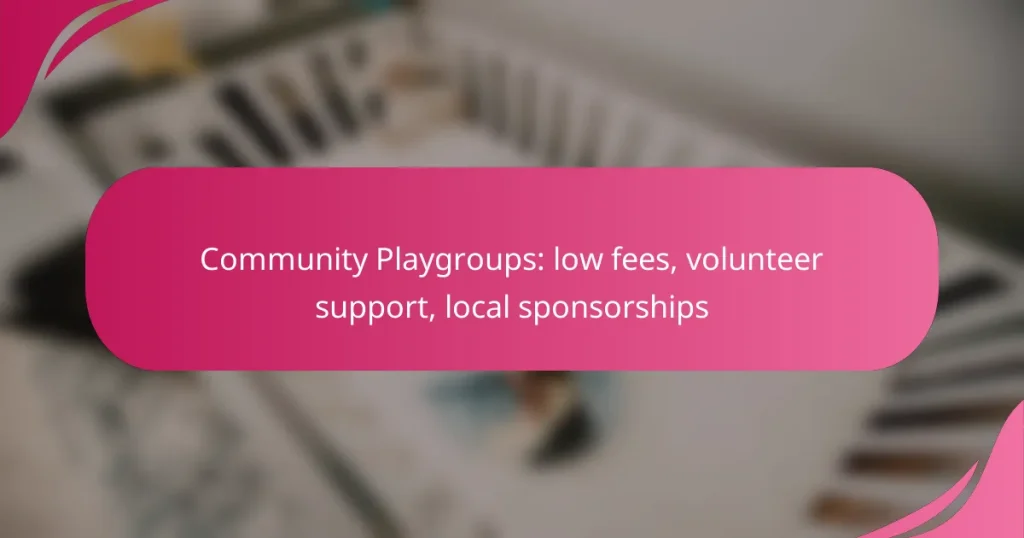When considering playgroup options, it’s essential to understand the varying costs and logistics associated with different types. Community playgroups often offer a more budget-friendly choice, while private and franchise models may come with higher expenses due to enhanced services. Additionally, factors such as location, staffing, and equipment requirements play a crucial role in the operation and effectiveness of these programs.
Pop-Up Playgroups: spontaneous fun, community involvement, flexible participation
Nature Playgroups: outdoor gear, transportation expenses, facility rentals
Structured Playgroups: registration fees, curriculum materials, staffing expenses
Sports Playgroups: equipment costs, facility rentals, coaching fees
Montessori Playgroups: tuition costs, materials investment, teacher training
STEM Playgroups: science experiments, technology projects, critical thinking
Language Playgroups: educational materials, language resources, staffing
Faith-Based Playgroups: donation-based funding, community support, event costs
Community Playgroups: low fees, volunteer support, local sponsorships
What are the costs of different playgroup types in urban areas?
The costs of various playgroup types in urban areas can vary significantly based on factors such as location, facilities, and the nature of the program. Generally, community playgroups tend to be more affordable, while private and franchise options can be more expensive due to additional services and amenities.
Community playgroups
Community playgroups are often the most cost-effective option, typically charging minimal fees or relying on donations. These groups are usually organized by local parents or community organizations and may operate in public spaces like parks or community centers.
Costs can range from free to around $50 per month, depending on the resources available. They often focus on socialization and basic activities, making them accessible for families on a budget.
Private playgroups
Private playgroups usually charge higher fees, reflecting the enhanced services they provide. These groups often have structured curricula, trained staff, and better facilities, which can lead to costs ranging from $100 to $500 per month.
When considering a private playgroup, evaluate the qualifications of the staff and the types of activities offered. Ensure that the environment aligns with your child’s needs and your budget.
Franchise playgroups
Franchise playgroups are part of larger networks and typically charge premium prices due to brand recognition and standardized programs. Monthly fees can range from $200 to $600, depending on the franchise’s reputation and location.
These playgroups often provide a consistent experience across locations, which can be beneficial for families who move frequently. However, assess whether the cost aligns with the educational value and social opportunities provided.
Online playgroups
Online playgroups have become increasingly popular, especially in urban areas where families may seek flexible options. Costs for online playgroups can vary widely, often ranging from free to around $100 per month, depending on the platform and services offered.
These groups can provide valuable social interaction and educational resources without the need for physical space. When choosing an online playgroup, consider the engagement level and the qualifications of the facilitators to ensure a positive experience for your child.
How do logistics vary among playgroup types?
The logistics of different playgroup types can significantly impact their operation and effectiveness. Key factors include location accessibility, staffing requirements, and equipment needs, all of which can vary widely based on the type of playgroup being offered.
Location accessibility
Location accessibility is crucial for ensuring that families can easily reach the playgroup. Urban playgroups may benefit from public transportation options, while rural settings might require more parking space and clear signage. Consider proximity to residential areas and safety of the surrounding environment when selecting a location.
Additionally, accessibility for children with disabilities should be a priority. Compliance with local regulations, such as the Americans with Disabilities Act (ADA) in the U.S., can enhance inclusivity and attract a broader range of participants.
Staffing requirements
Staffing needs can vary based on the playgroup type, with some requiring specialized skills. For instance, educational playgroups may need certified teachers, while recreational groups might focus more on general supervision. A common guideline is to maintain a low adult-to-child ratio, often around 1:5 to 1:10, depending on the age group.
It’s essential to ensure that staff members are trained in child development and first aid. Regular training sessions can help maintain high standards and ensure a safe environment for all children.
Equipment needs
The equipment required for a playgroup can differ significantly based on its focus. Educational playgroups may need books, art supplies, and learning materials, while physical playgroups might require playground equipment and sports gear. Budgeting for these items is critical, with costs potentially ranging from a few hundred to several thousand dollars depending on the quality and quantity of equipment.
Consider the maintenance and safety of equipment as well. Regular inspections and adherence to safety standards can prevent accidents and ensure a safe play environment. Investing in durable, age-appropriate equipment can also save costs in the long run by reducing the need for frequent replacements.
What factors influence playgroup pricing in metropolitan regions?
Playgroup pricing in metropolitan areas is influenced by various factors including facility rental costs, insurance expenses, and marketing budgets. Understanding these elements can help in budgeting effectively for a playgroup.
Facility rental costs
Facility rental costs can vary significantly based on location, size, and amenities. In metropolitan regions, expect to pay anywhere from a few hundred to several thousand USD per month for suitable spaces. Consider negotiating long-term leases for better rates and ensure the facility meets safety regulations.
When selecting a venue, assess factors such as accessibility, parking availability, and proximity to public transport. These can impact attendance and overall satisfaction.
Insurance expenses
Insurance expenses are a critical component of playgroup costs, as they protect against liability and accidents. Depending on the coverage level, annual premiums can range from a few hundred to a couple of thousand USD. It’s advisable to consult with an insurance agent to find a policy that meets legal requirements and adequately covers your activities.
Be aware of any specific regulations that may apply in your metropolitan area, as some regions may have unique insurance requirements for child-focused activities.
Marketing budgets
Marketing budgets are essential for attracting participants to your playgroup. Costs can vary widely, from free social media promotions to several thousand USD for targeted advertising campaigns. A practical approach is to allocate a percentage of your overall budget to marketing efforts, typically around 10-20% for new playgroups.
Utilize local community boards, social media platforms, and partnerships with schools or childcare centers to maximize outreach without overspending. Regularly assess the effectiveness of your marketing strategies to ensure optimal use of resources.
How do community playgroups compare to private playgroups?
Community playgroups are typically more affordable and accessible than private playgroups, which often offer specialized services and amenities. Understanding the differences in cost, services, and target demographics can help parents choose the best option for their children.
Cost differences
Community playgroups generally have lower fees, often relying on volunteer support and local funding. Costs can range from free to a few hundred USD per year, depending on the location and resources available.
In contrast, private playgroups may charge significantly higher fees, sometimes exceeding several thousand USD annually. These costs reflect the enhanced facilities, staff qualifications, and tailored programs offered.
Service offerings
Community playgroups usually focus on socialization and basic developmental activities, providing a nurturing environment with limited structured programming. They often emphasize play-based learning and community involvement.
Private playgroups, however, may offer a wider array of services, including specialized educational programs, smaller class sizes, and additional resources like on-site therapists or enrichment activities. This can lead to a more individualized experience for children.
Target demographics
Community playgroups often cater to a diverse range of families, promoting inclusivity and accessibility for all socioeconomic backgrounds. They may prioritize local residents and families with limited resources.
Private playgroups typically attract families seeking specific educational philosophies or higher-end services. These groups may appeal to parents willing to invest more in their children’s early education, often resulting in a more homogeneous demographic.
What are the logistical challenges of running a playgroup?
Running a playgroup involves various logistical challenges, including compliance with regulations and ensuring health and safety protocols. These factors are critical for creating a safe and nurturing environment for children, which requires careful planning and management.
Compliance with regulations
Compliance with regulations is essential for any playgroup. This includes adhering to local laws regarding child-to-staff ratios, facility safety standards, and licensing requirements. For example, many regions require a minimum of one adult for every three to five children, depending on their age.
To navigate these regulations effectively, it is advisable to consult local authorities or childcare organizations. Keeping up-to-date with changes in legislation can prevent potential fines or operational disruptions. Regular training for staff on compliance issues can also help maintain standards.
Health and safety protocols
Implementing health and safety protocols is crucial for protecting children in a playgroup setting. This includes regular cleaning of toys and play areas, conducting health screenings for staff and children, and having emergency procedures in place. For instance, many playgroups conduct daily health checks to identify any signs of illness before children enter the facility.
Additionally, creating a comprehensive safety plan that includes first aid training for staff and emergency contact information is vital. Regular drills and updates to the safety plan can ensure that everyone is prepared for unexpected situations, enhancing the overall safety of the playgroup environment.









